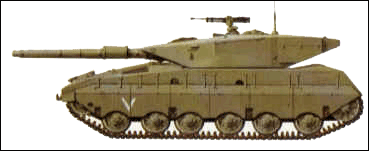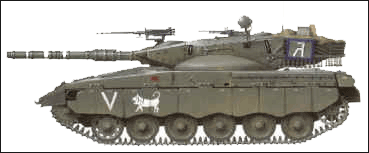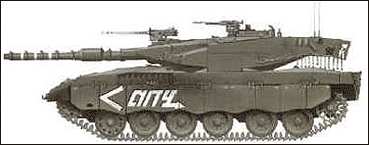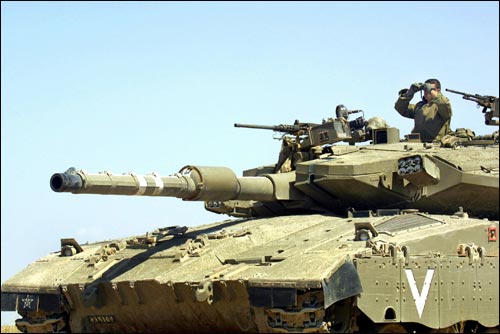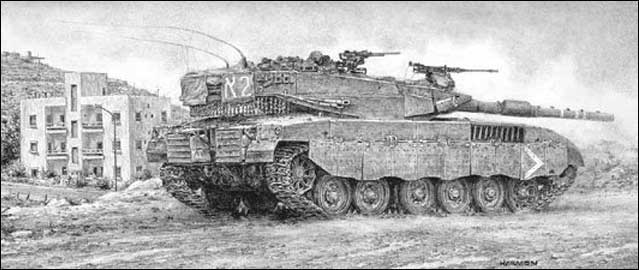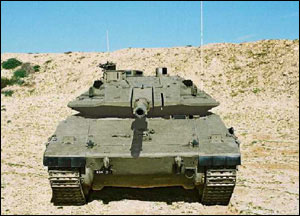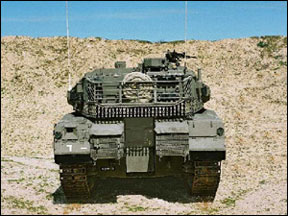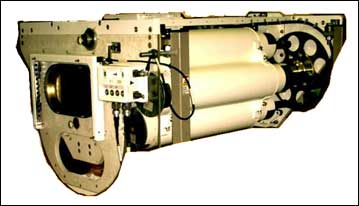ISRAEL'S MAIN BATTLE TANK: THE MERKAVA (CHARIOT) HISTORY: The Sinai Campaign of 1956 was characterized by mobile, armored warfare. Israel deployed 200 tanks in Sinai, versus 150 tanks deployed by the Egyptians. Since the Sinai Campaign, the land war between Israel and the surrounding Arab nations has become a war of highly mobile and armored formations. A total of 2,500 tanks were deployed during the Six-Day War by Israel and the enemies. 6,200 tanks engaged in combat during the Yom-Kippur war. Since the Sinai Campaign, thousands of tanks have been destroyed in battle. Today, the tank is central to the art of war, and is considered the primary decisive factor on the modern land battlefield. Prior to the Sinai Campaign Egypt received, within the framework of the "Czechoslovakian Arms Deal", 300 Soviet tanks and tank destroyers, including the Stalin-3 and T-34 tanks and SU-100 tank destroyers. This was considered an impressive addition to the Egyptian armored fleet, which at that time numbered some 430 western armored vehicles, of various types. At that time, Israeli weaponry was always inferior in both qualitative and quantitative aspects, consisting mainly of World War Two vintage Shermans, and French AMX-13 tanks. Some years later, Israel managed to acquire some British Centurions and American M48 Patton tanks, and more recently, some American M60 Main Battle Tanks. But the numeric and qualitative inferiority continued, and Israel had no option except to start developing their own armored force, with whatever resources available. The first step was the modernization of the tanks and armored vehicles they already had. Israel proved, by the means of their ingenuity, to be able to upgrade their available armored force up to a point that they could, by the means of a very well thought concept of combined arms warfare, plus the introduction of new training systems for their troops, to defeat all threats and to advance and occupy part of enemy territory, overcoming the superiority those enemies appeared to have. In time, the continuity of the ever present possibility of war ensued the decision, by the Israelis, to develop their own Main Battle Tank. The original plan was for the development of a tank to be based primarily on existing systems and components. But, as a result of various know-how restrictions, specific technological reasons and operational requirements, it become clear that if Israel was to develop an entirely new tank, it would necessarily have be based not only on existing systems, but also on entirely new developments and original components. With the objective of reducing the development time to a minimum, it was adopted a philosophy of "telescopic development" process. This method is characterized by the start of serial production, based on prototypes, before completion of all development and demonstration stages. So, the last development stages were happening as the production process itself was going on. Merkava Development:
It was also decided to utilize the industrial infrastructures existing within the IDF, the civilian and governmental military industries, expanding the manufacturing potential of existing plants where necessary. The existing IDF basic tank depot was to be utilized as the tank's final assembly plant. In addition, two hundred industrial plants would be upgraded with new technologies and capabilities, as required for the manufacture of the thousands of parts, components and systems, needed for the production of the Merkava MBT. It was decided that any technological knowledge which may be lacking would be acquired in part from abroad, and in part developed within the country's own defense and industrial establishments and by Israeli research institutes. THE MERKAVA
The Merkava is the main battle tank in service with the Israeli armed forces. The first Merkava Mk 1 tanks were supplied to the Israeli Defense Forces (IDF) in 1979. Production of the Mk 1 continued up to 1983, when the IDF began to receive the Merkava Mk 2. The Mk 2 featured improved mobility, fire control system and armour, as well as the inclusion of an internal 60 mm mortar. Production of Mk 2 continued until 1990 when it was superseded by the Mk 3. The Merkava Mk 3 Baz entered service with the IDF at the beginning of 1990. The main features of the Merkava Mk 3 are a new suspension system, a 1200 horsepower engine and new transmission, a higher power main gun, and particularly new armour protection. Ballistic protection is provided by special armour modules, which are attached to the tank by bolts. These are easily replaced whenever better ballistic technology is introduced. About 1200 Merkava Mk 2 and Mk 3 tanks are in service with the IDF.
The Merkava is the innovative Israeli design of Major General Israel Tal. The primary design criteria was crew survivability. Every part of the overall design is expected to contribute to helping the crew survive. The engine is in the front to provide protection to the crew. There is a special protective umbrella for the tank commander to enable protection from indirect fire with the hatches open. Special "spaced armor" is in use along with protected fuel and ammo compartments. Rear ammunition stowage is combined with a rear entrance and exit. Since the rounds are stowed in containers that can be removed from the vehicle whenever necessary, this space can accommodate tank crewmen who have been forced to abandon their vehicles, or, if thought to be appropriate, even infantrymen. Rear ammunition stowage allows replenishment much more easily than if rounds have to be replaced in a carousel in the hull center, as in typical Russian vehicles. Tank soldiers have long admired Merkava's rear entrance and exit, recognizing that it would allow them to mount and dismount unobserved by the enemy and would provide an excellent alternative escape route. The Merkava can also carry a small Infantry squad internally under complete armored protection.
Merkava Mk-4 Merkava Mk.4 Main Battle Tank. The IDF has begun to equip itself with the Merkava Mk-4 tank, which was completely developed in Israel and is considered one of the best tanks in the world. The new tank, a fourth generation of the Israeli tank, is currently in production, and is expected to enter operational status with a regular tank brigade, replacing older M-60 (Magach) tanks currently in service. It represents a sensible improvement over its three predecessors of the Merkava series, being a more lethal weapon on the one hand, and a safer vehicle for its crew, on the other.
The Merkava Mk-4 includes innovations in all tank quality components - protection and survivability, firepower and mobility. Protection and survivability The principles on which the design of the Merkava tank family development was based have been applied again in the Merkava Mk-4. Priority has been given to protection and survivability, utilizing the tank's systems for protecting the crew (the engine is installed in the front of the tank), with storage of ammunition in protected containers, automatic fire suppression system, an overpressure NBC system, and more. The Merkava is one of the best protected tanks in the world. Its advanced protective systems provide increased protection against penetration of APFSDS shells and all known ATGM's, and its sensors are capable of detecting the launch of such missiles in advance, including laser-guided missiles. The tank's is fitted with the Amcoram LWS-2 laser warning system, with threat warning display installed at the commander's station. In the Merkava Mk-4, the ballistic protection is modular and provides more effective protection against modern threats, involving both protection efficiency and coverage area. Above all, the ballistic protection includes roof protection, which provides a capability against overhead attacks. The electromagnetic threat identification warning system is an advanced generation of its predecessor in the Mk-3. The turret and the hull are fitted with a modular armour system which can be changed in the field. The forward section of the turret is fitted with additional blocks of armour which provide extra protection against the latest generation of top attack anti-tank missiles. A skirt of chains with ball weights is installed on the lower half of the turret bustle. Incoming HEAT projectiles detonate on impact with the chains instead of penetrating the turret ring. Sprung armour side skirts protect the wheels and tracks. Firepower The tank is equipped with a 120-mm gun that is an advanced generation of the type developed for the Merkava Mk-3. Its 120mm gun is also modified to sustain higher pressures, resulting in improved range and penetration performance. The new gun provides for firing of high-power munitions with increased penetrating capabilities. The ready-to-fire ammunition is stored in a protected compartment. The system allows the loader to semi-automatically select the desired ammunition type.
The tank's new fire control system includes modern components, whose capabilities are very high in detection range and target acquisition. The night vision system is based on the world's leading thermal technology. The automatic tracking ability has been significantly improved. The systems provide for the implementation of an effective combat doctrine in target acquisition, allocation and destruction by commander and gunner. The system which supports the fire power is controlled by displays and advanced operating systems, helping the commander with effective data communication and battle management. The tank carries an ammunition store of 50 rounds of 120 mm ammunition. The tank is also equipped with three 7.62 mm machine guns, two roof mounted and one co-axial with the main gun. The tank carries a store of 10,000 rounds of 7.62 mm ammunition. The 60 millimeter mortar system, which is a large caliber gun with a low muzzle velocity, is capable of firing high explosive rounds and illumination bombs. The crew can load, aim and fire the mortar system from within the turret. The mortar system is developed by Soltam Limited of Haifa.  Merkava Mk.3 firing LAHAT 120mm missile. A series of live firing tests of the LAHAT - Laser Guided anti-tank missile developed by IAI/MBT (Israel Aircraft Industries-MBT Division) included the firing of 120mm missiles, adapted for smooth-bore guns used on Merkava Mk3, Merkava Mk4, Leopard 2A5/6 and M1A1/A2 Abrams tanks. The missile is also designed for employment from launch tubes, where it could be deployed from fixed positions, light vehicles or APC's. The missile’s trajectory can be set to match either tank (top attack) or helicopter (direct attack) engagement. Finally, the missile uses a tandem warhead which can defeat modern armour and reactive panels. The main warhead has a high penetration capability, defeating all known armored vehicles at high impact angles typical of top attack trajectories. Mobility The Merkava Mk-4 tank is equipped with a modern engine. This is a 1,500 horse power American-built diesel engine, controlled by a computer connected both to the driver's panel and to the modern automatic transmission system, affording the tank greater power than the previous version, which has a 1,200-horsepower engine. Some of the new models have already covered more than 10,000 kilometers in field tests. The engine and transmission constitute a power pack that is considered a world leader. The great power of the engine, in conjunction with the strong suspension based on that of the Mk-3, provide the tank with high mobility and maneuverability. The installation of the new power pack in the Merkava tank has allowed for a redesign of the hull in a way that has improved frontal protection and the driver's field of view. For improving reverse driving, a camera has been developed which enables the driver to look behind the tank while driving backwards without requiring commander or ground direction. According to the tank's designers, headed by the progenitor of the Merkava, Maj. Gen. (res.) Israel Tal, the fourth generation represents a quantum leap forward. Part of the revolution lies in the fact that the tank will, for the first time, be equipped with full perimeter defense, both vertical and horizontal. This, combined with an advanced observation and control system, will enable the tank commander to function from the turret with full protection from external threats such as anti-tank missiles. The Mk-4 will be equipped with a central filtering system for protection against nuclear-biological-chemical threats, enabling the crew to function without face masks or cumbersome protective suits. The Mk-4 retains the hull design of the previous Merkava versions. Unique among the main battle tanks of the world, the Merkava design features a front-mounted engine and battery, room inside for several full armed soldiers in addition to the crew and a rear access hatch allowing for the quick evacuation of crews and injured soldiers. Enemy fire directly striking the front of the tank, the most likely point of attack, is absorbed by the mass of the engine block, protecting the crew. The engine pack is easily replaced. 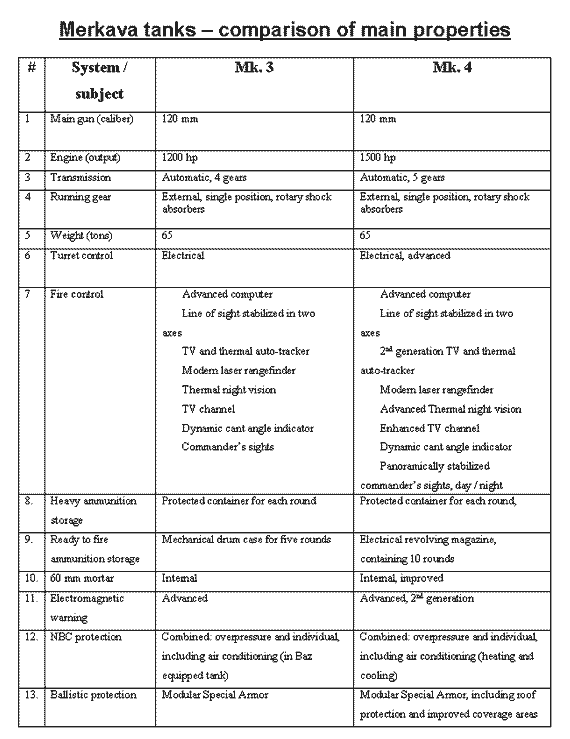 |

